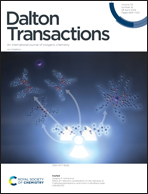Designing a hybrid nanomaterial based on Cr-containing polyoxometalate and graphene oxide as an electrocatalyst for the hydrogen evolution reaction†
Abstract
A new polyoxometalate (POM)-based hybrid nanomaterial (denoted as PMo11-Cr-mGO) was designed via covalent interaction between the Cr(acac)3 complex and [PMo11O39]7− followed by immobilization on the surface of modified graphene oxide (mGO). The prepared nanomaterial was characterized using a series of physicochemical techniques. X-ray diffraction (XRD), Raman analysis, transmission electron microscopy (TEM), and FE-SEM-EDS revealed the preservation of layered GO during the formation of the desired hybrid nanomaterial. Fourier transform infrared (FT-IR), X-ray photoelectron spectroscopy (XPS), and elemental analysis confirmed the immobilization of POM (PMo11-Cr) on the surface of mGO and the formation of PMo11-Cr-mGO. In order to evaluate the performance of PMo11-Cr-mGO in the hydrogen evolution reaction (HER), electrochemical measurements were also performed. The resulting PMo11-Cr-mGO exhibited excellent HER activities with a low overpotential of 153 mV at 10 mA cm−2 and good durability in acidic media, thus emerging as one of the most efficient POM-based electrocatalysts.



 Please wait while we load your content...
Please wait while we load your content...